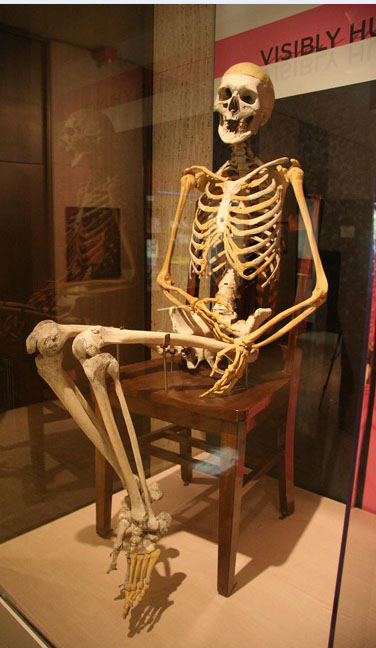Visibly Human Health and Disease in the Human Body
Skeleton of Spanish American War Veteran Showing Evidence of Severe Arthritis
 Peter Cluckey was born on Sept. 16, 1882 in Lansing, Michigan and enlisted in
the U.S. Army when he was 17 years old, just after the Spanish-American War. He
retired from the Army after just three years, but rejoined in 1904.
Peter Cluckey was born on Sept. 16, 1882 in Lansing, Michigan and enlisted in
the U.S. Army when he was 17 years old, just after the Spanish-American War. He
retired from the Army after just three years, but rejoined in 1904.
Two months after his second enlistment, Cluckey experienced joint pain and stiffness after a horseback-mounted drill held in a cold rain. He endured several medical examinations and was diagnosed with “rheumatism chronic, articular, affecting both hips, knees, and ankle joints, and the right elbow.”
He was treated at the Army and General Hospital in Arkansas with sodium salicylate (an analgesic), potassium iodide, hydrotherapy and other methods, but discharged from the institution and the U.S. Army in 1905 with a Certificate of Disability.
Despite a variety of treatments over the next 20 years, his condition worsened to the point where every joint in his body became fused together. Cluckey was moved into a sitting position so he could be placed in a chair or on his side in bed to sleep. Four front teeth were removed in 1921 so that he could be fed soft foods. He lived out the last 15 years of his life at the United States Soldiers Home in Washington, D.C.
Cluckey died on Sept. 10, 1925 at the age of 43. He was so impressed with the significance of his disease and the inability of the medical doctors of the time to comprehend the disease and cope with it, that he gave his body to the Army Medical Museum (the progenitor of today’s National Museum of Health and Medicine) for study. Doctors determined during the autopsy that Cluckey had suffered from chronic progressive ankylosing rheumatoid arthritis and spondylitis severe enough to render him completely helpless.
The skeleton, which has been on display in a wooden chair since Cluckey’s death, features most of its original bones. However, several bones tinted yellow (see the specimen or these images) are replacements from another skeleton for the original diseased bones which were removed after death.

- Visibly Human Health and Disease in the Human Body
- The Cardiovascular System
- The Urinary System
- Respiratory System
- The Lymphatic System
- The Musculoskeletal System
- The Liver and Hepatic System
- The Digestive System
- The Brain and Nervous System
- Psychiatric Patients at Forest Glen
- Skeleton of Spanish American War Veteran Showing Evidence of Severe Arthritis



